NICHIREN SHŌNIN AND HONMONJI TEMPLE |
NICHIREN SHŌNIN  Nichiren Shōnin’s studies of the various Buddhist teachings, beginning
with the Tendai Order at its headquarters on Mt. Hiei, convinced him that
the true and only doctrine, the quintessence of Buddhism, was the Lotus
Sutra (Hokke Sutra, the Sutra of the Lotus Flower of the Wonderful Dharma,
or Saddharma Pundarika Sutra). He resolved that henceforth all Buddhist
scripture should be judged in its light. His devotion was so deep that
he changed his name to Nichiren. Nichiren means “Sun Lotus.” He described
his name as follows: Nichiren Shōnin’s studies of the various Buddhist teachings, beginning
with the Tendai Order at its headquarters on Mt. Hiei, convinced him that
the true and only doctrine, the quintessence of Buddhism, was the Lotus
Sutra (Hokke Sutra, the Sutra of the Lotus Flower of the Wonderful Dharma,
or Saddharma Pundarika Sutra). He resolved that henceforth all Buddhist
scripture should be judged in its light. His devotion was so deep that
he changed his name to Nichiren. Nichiren means “Sun Lotus.” He described
his name as follows:“There is nothing so clear and serene as the sun and the moon, and nothing purer than the lotus flower. The Lotus of the Perfect Truth is like the sun and the moon and the lotus flower.” This description of his name was itself derived from two famous passages in the Lotus Sutra: “As the sun and the moon together are responsible for making the dark places bright, so too is man, whose works bring light and happiness to all living creatures in the world. Not to be infected with worldly events, but to remain pure like the lotus in muddy pond.” |
| Most people during Nichiren Shōnin’s era longed to escape from the troubles
of the world: civil wars, calamities, plagues and famine. They sought deliverance
through the Pure Land of Amida Buddha as taught by the Pure Land Order.
Nichiren Shōnin, however, taught that the desire to seek rebirth in the
Pure Land through recitation of the name of Amida Buddha (Namu-Amida-Butsu)
represented a denial of oneself in the present world. He insisted that
there could be no elevation of the mind unless one attempted to attain
Buddhahood through one’s own efforts. Simple reliance upon Amida Budha
and the desire to be reborn after death without seeking enlightenment on
one’s own were, along with reliance on scriptures other than the Lotus
Sutra, the principal causes of social disorder at that time. His strong
faith in the Lotus Sutra and the Eternal Buddha Śākyamuni caused him to
harshly criticize both the contemporary and the older orders of Buddhism.
In 1253, when he was 31 years old, Nichiren Shōnin chanted the Odaimoku for the first time. Odaimoku means “sacred title (of the Lotus Sutra),” which is Namu-Myoho-Renge-Kyo (I devote myself to the Sutra of the Wonderful Dharma like the Lotus Flower ). In the firm belief that the catastrophic events of the time resulted from mistaken worship, he proclaimed that only the Lotus Sutra could protect the nation and the people. He became convinced that if the teachings of the Lotus Sutra were practiced, peace and happiness would come without fail to both individuals and the whole nation. Nichiren Shōnin strongly advocated the attainment of Buddhahood on this earth through utter devotion to the Lotus Sutra by chanting the Odaimoku. Because of this extreme advocacy of the Lotus Sutra and his sharp criticism of other Buddhist orders, Nichiren Shōnin was often persecuted by the Kamakura Shogunate and was finally exiled to a small island, Sado off the coast of Japan. One of the passages in the Lotus Sutra clearly prophesized religious persecution for those who dare proselytize it during the Latter Age of Degeneration, called Mappō. The persecutions against Nichiren Shōnin convinced him even more of the truthfulness of the Lotus Sutra’s teachings. He became aware of himself as the epitome of the compassionate Bodhisattva Jōgyō (Visistacarita Bodhisattva,Super Conduct) who had been entrusted by the Eternal Śākyamuni Buddha with propagating the truth of the Lotus Sutra. Nichiren Shōnin knew that he must lead in the dissemination of the Lotus Sutra and begin this dissemination in Japan, his home. So he made the following vows: “I will be a pillar of Japan. I will be the eyes of Japan. I will be a vessel of Japan.” According to the Lotus Sutra, the historical Buddha, Śākyamuni, was one of realization with the eternal and immortal truth, which is identic with the Eternal Śākyamuni Buddha. An ordinary person obsessed with desire and craving cannot help but feel that this world is full of suffering, but the enlightened person with true vision sees the world as it is. Though a person’s prayers will not quickly change the world, they will transform their inner self and this personal metamorphosis will in turn lead slowly but surely to real change in the external reality of their world. Through this real awakening, one realizes for the first time that there is more to the world than suffering.One reaches the world of the Eternal Śākyamuni Buddha by having deep faith and pledging one’s deep devotion to him. Repetition of the Odaimoku is not comparable to mere chanting, but must be done with one’s whole body, voice and spirit. Through this practice, one progresses along the road to Enlightenment. It was Nichiren Shōnin’s ideal to establish the Buddha’s pure land on this earth by developing the Buddha-nature possessed by all beings. Nichiren Shōnin’s disciples and followers are strongly encouraged to follow the example he set with his life. Nichiren Shōnin believed that the Eternal Śākyamuni Buddha had put all his teachings, merit and compassion into the Odaimoku and because of this he created the Great Mandala with the Odaimoku as its focus. The sacred Great Mandala conceived by Nichiren Shōnin is a visual (calligraphic) representation of the names of the Buddhas and Bodhisattvas of the Lotus Sutra which surround the Namu Myoho Renge Kyo (Odaimoku). Thus, in the Nichiren Shū Order, this Great Mandala, the graphic representation of the truth of the teachings of the Lotus Sutra, is the Most Venerable One.Nichiren Shōnin had selected only the teachings of the Lotus Sutra from the various schools of Buddhist thought and presented all the Buddha’s teachings and compassion in the form of the Odaimoku. He passed away on October 13, 1282, at the age of 61, in Ikegami, Tokyo. In accordance with his will, his ashes were buried in the precincts of Kuonji Temple (Head Temple of Nichiren Shū Order) at Minobu, Yamanashi Prefecture. |
Honmonji Temple |
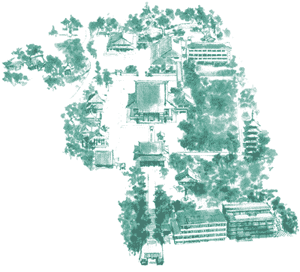 Nichiren Shōnin founded Honmonji Temple (one of the official designation
[Sangō], is Chōei-zan or “ever-flourishing mountain”) just before his death
in October of 1282 at the request of Ikegami Munenaka, a wealthy feudal
lord and faithful follower. Ikegami Munenaka offered 69,384 tsubo of land
(51.89 acres) which corresponds to the number of Chinese characters in
the Lotus Sutra. On April 15 1945, the temple was subjected to heavy bombing,
resulting in the destruction of all the structures except the main gate,
the five-story pagoda, the Kyōzō (repository of Buddhist scriptures) and
the Tahōtō (a stupa). The Temple was completely reconstructed through contributions
of followers throughout the country. Nichiren Shōnin founded Honmonji Temple (one of the official designation
[Sangō], is Chōei-zan or “ever-flourishing mountain”) just before his death
in October of 1282 at the request of Ikegami Munenaka, a wealthy feudal
lord and faithful follower. Ikegami Munenaka offered 69,384 tsubo of land
(51.89 acres) which corresponds to the number of Chinese characters in
the Lotus Sutra. On April 15 1945, the temple was subjected to heavy bombing,
resulting in the destruction of all the structures except the main gate,
the five-story pagoda, the Kyōzō (repository of Buddhist scriptures) and
the Tahōtō (a stupa). The Temple was completely reconstructed through contributions
of followers throughout the country. 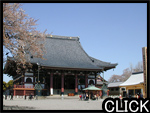 Going up the front steps and walking through the Niō-mon (a gate with two
guardian deities), the visitor comes to the Soshi-dō (founder’s hall) where
a statue of Nichiren Shōnin is enshrined. This statue was commissioned
by his disciples on the seventh anniversary of his death. Going up the front steps and walking through the Niō-mon (a gate with two
guardian deities), the visitor comes to the Soshi-dō (founder’s hall) where
a statue of Nichiren Shōnin is enshrined. This statue was commissioned
by his disciples on the seventh anniversary of his death. Behind the Soshi-dō, we find the Honden (main hall) where Śākyamuni Buddha and the four Bodhisattvas are enshrined. 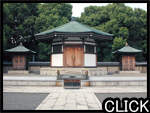 Behind the Honden is the octagonal Gobyō-sho (mausoleum), which was built on the occasion of the 700th anniversary of his death and is where some of the ashes of Nichiren Shōnin are enshrined. It is constructed entirely of Japanese cypress (hinoki).  The five-story pagoda was built in 1608. It stands just inside the Niō-mon
to your right. It is 29.4 meters high (96.45’) with a diameter of 41 centimeter
(16.1”) octagon beam running from the top to the second story in order
to balance the structure. It is constructed to withstand a magnitude seven
earthquake and is the oldest five-story pagoda in Tokyo. The five-story pagoda was built in 1608. It stands just inside the Niō-mon
to your right. It is 29.4 meters high (96.45’) with a diameter of 41 centimeter
(16.1”) octagon beam running from the top to the second story in order
to balance the structure. It is constructed to withstand a magnitude seven
earthquake and is the oldest five-story pagoda in Tokyo. Both the statue of Nichiren Shōnin in the Soshi-dō and the five-story pagoda have been designated as important cultural property of Japan. 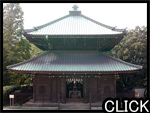 The Kyōzō was built in 1784 and houses the whole Buddhist cannon in revolving
octagonal bookshelves. The Kyōzō was built in 1784 and houses the whole Buddhist cannon in revolving
octagonal bookshelves. Facing the Soshi-dō it is to the left. If you travel to just behind the Soshi-dō and take a left, find the stone step going down the step, you will find the Tahōtō (Stupa) on the right hand. 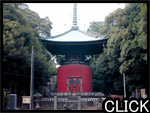 The Tahōtō is a red pagoda, which was built on the site where Nichiren
Shōnin was cremated. It was rebuilt in 1830 and is the only structure of
its kind in Japan. The Tahōtō is a red pagoda, which was built on the site where Nichiren
Shōnin was cremated. It was rebuilt in 1830 and is the only structure of
its kind in Japan.The history of Honmonji Temple stretches back some 700 years to its founding by Nichiren Shōnin. Along with Kuonji Temple at Minobu in Yamanashi Prefecture (the head temple of the Nichiren Shū Order) Honmonji Temple ranks as one of the major centers among the order’s 5,000 temples. |
Oeshiki |
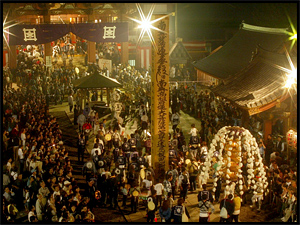 Oeshiki is a Buddhist ceremony commemorating Nichiren Shōnin’s memorial
day, who passed away at Ikegami on October 13, 1282. On the night of October
12, crowds jam the precincts of Honmonji Temple. Oeshiki is a Buddhist ceremony commemorating Nichiren Shōnin’s memorial
day, who passed away at Ikegami on October 13, 1282. On the night of October
12, crowds jam the precincts of Honmonji Temple. The ceremony reached its height on the eve of October 13, with parades of mandō (which literally means “10,000 lanterns”) and Matoi (firemen’s standards of the Edo period) accompanied by flutes and drums. The Nichiren Shōnin’s memorial ceremony attracts hundreds of thousands of the faithful. 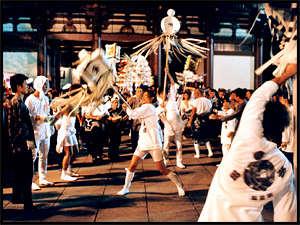 The mandō are something like a parade float, which are about 5 meters (16.4’) in height. In its structure built in the form of a five-story pagoda with the Odaimoku (Namu Myoho Renge Kyo) or pictures of Nichiren Shōnin’s life depicted on the sides. The whole structure is lit from the inside and rows of artificial cherry blossoms are hung from the top on an umbrella to from a cherry tree, because it is said that when Nichiren Shōnin passed away the cherry trees came into bloom out of season.  Oeshiki is a grand celebration of our founder’s life. |
| Copyright(c) IKEGAMI HONMONJI All Rights Reserved. |